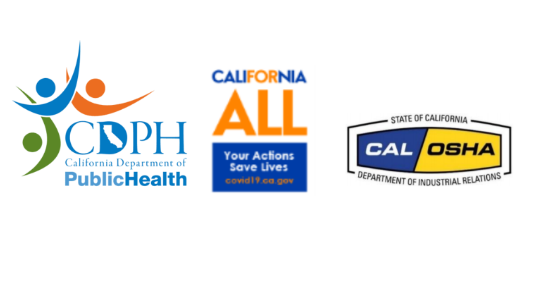Title Page
-
Conducted on
-
Prepared by
-
Location
Contents of Written Worksite Specific Plan
-
The person(s) responsible for implementing the plan.
-
A risk assessment and the measures that will be taken to prevent spread of the virus.
-
Training and communication with employees and employee representatives on the plan.
-
A process to check for compliance and to document and correct deficiencies.
-
A process to investigate COVID-cases, alert the local health department, and identify and isolate close workplace contacts of infected employees until they are tested.
-
Update the plan as necessary to prevent further cases.
Topics for Employee Training
-
Information on COVID-19, preventing spread, and who is especially vulnerable. <br>https://www.cdc.gov/coronavirus/2019-ncov/index.html
-
Self-screening at home, including temperature and/or symptom checks using CDC guidelines.<br>https://www.cdc.gov/coronavirus/2019-ncov/symptoms-testing/symptoms.html
-
The importance of not coming to work if employees have a frequent cough, fever, difficulty breathing, chills, muscle pain, headache, sore throat, the recent loss of taste or smell, or if they or someone they live with has been diagnosed with COVID-19.
-
When to seek medical attention.
-
The importance of hand washing.
-
The importance of physical distancing, both at work and off work time.
-
Proper use of cloth face covers
Individual Control Measures and Screening
-
Symptom screenings and/or temperature checks.
-
Encourage workers who are sick or exhibiting symptoms of COVID-19 to stay home.
-
Encourage frequent handwashing and use of hand sanitizer.
-
Provide disposable gloves to workers using cleaners and disinfectants when required. Consider gloves as a supplement to frequent handwashing for other cleaning, tasks such as handling commonly touched items or conducting symptom screening.
-
Strongly recommend use of cloth face covers.
-
Communicate frequently to customers that they should use face masks/covers.
Cleaning and Disinfecting Protocols
-
Perform thorough cleaning in high traffic areas.
-
Frequently disinfect commonly used surfaces.
-
Clean and sanitize shared equipment between each use.
-
Clean touchable working surfaces between shifts or between users, whichever is more frequent.
-
Equip terminals, desks, and help counters with proper sanitation products, including hand sanitizer and sanitizing wipes, and provide personal hand sanitizers to all staff assisting.
-
Provide hand sanitizer dispensers throughout showrooms, lobbies, and service areas, for use by customers and employees
-
Ensure that sanitary facilities stay operational and stocked all times.
-
Use products approved for COVID-19 on the Environmental Protection Agency (EPA)-approved list and follow product instructions and Cal/OSHA requirements.<br>https://www.epa.gov/pesticide-registration/list-n-disinfectants-use-against-sars-cov-2
-
Dedicate employees to sanitize vehicles returning from rental and test drives as well as other high-touch surfaces in lobbies, showroom
-
Use protective barriers such as disposable mats and seat covers when using vehicles, such as during test drives and moving return vehicles.
-
Adjust or modify store hours to provide adequate time for regular deep cleaning.
-
Install hands-free devices as possible.
-
Encourage the use of debit or credits by customers.
-
Consider upgrades to improve air filtration and ventilation.
Physical Distancing Guidelines
-
Implement measures to physically separate workers by at least six feet using measures such as physical partitions or visual cues (e.g., floor markings, colored tape, or signs to indicate to where workers should stand).
-
Install barriers such as Plexiglas, where feasible, in areas where physical distancing cannot be maintained.
-
Use signage at all entrances and strategically throughout the facility to remind customers of physical distancing and face cover use at every opportunity.
-
Increase distances between tables/chairs in showrooms and waiting areas to ensure physical distancing.
-
Adjust in-person meetings, if they are necessary, to ensure physical distancing.
-
Place additional limitations on the number of persons in enclosed areas like supply closets to ensure at least six feet of separation.
-
Redesign office spaces, cubicles, etc. to ensure workspaces allow for six feet between employees.
-
Stagger employee breaks, in compliance with wage and hour regulations, to maintain physical distancing protocols.
-
Reconfigure, restrict, or close common areas to maintain physical distancing or move to open areas.
-
Adjust maximum occupancy rules based on the size of your facility to limit the number of people in a store, office, or showroom at one time.
-
Provide a single, clearly designated entrance and separate exit to help maintain physical distancing, wherever possible.
-
Ask vendors who must enter the facility to follow physical distancing and to use face covers.
-
Allow only one customer in vehicles during test drives with the employee sitting in the opposite back seat. Both customers and employees must wear face covers.
-
Encourage customer appointments and request that customers follow physical distancing and face cover recommendations while waiting for service using visual cues or ask customers to wait in their vehicles.
-
Offer curbside delivery or pickup and move sales and agreements to remote/digital platforms as feasible.
-
Discontinue shuttle services.
-
Require employees to not use handshakes and similar greetings that break physical distance.
Sign Off
-
Name and Signature
















